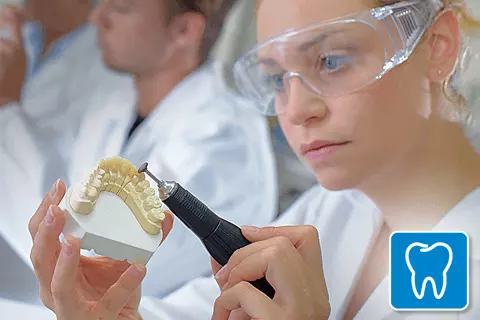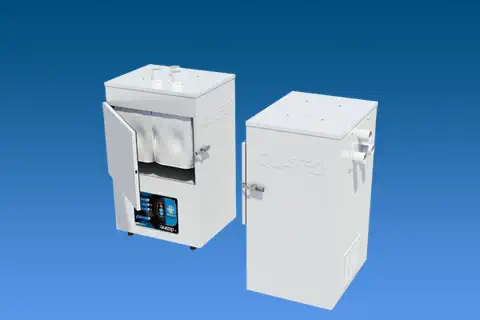Dental Industry
Overview
 Professionals in the dental industry face a number of challenges when it comes to maintaining good air quality in their offices and labs. Even simple dental procedures such as cavity drilling and filling can release harmful chemicals into the air as well as promote disease transmission and spread.
Professionals in the dental industry face a number of challenges when it comes to maintaining good air quality in their offices and labs. Even simple dental procedures such as cavity drilling and filling can release harmful chemicals into the air as well as promote disease transmission and spread.
Without the use of proper air filtration systems, working as a dental professional can be one of the most hazardous jobs to one’s health. The U.S. Department of Labor placed prosthodontists as the seventh most unhealthy job in America. Dental assistants came in fifth, dental laboratory technicians fourth, general dentists second and dental hygienists first due to exposure to contaminants, disease and radiation.
Most dental laboratories and offices rely only on source control devices and their heating, ventilation and air conditioning (HVAC) systems to maintain clean air. But source control devices fail to capture all contaminants produced and HVAC systems function only to keep indoor temperature at comfortable levels.
To ensure a healthy environment for both patients and staff, dental professionals must employ multiple strategies to manage and capture airborne toxins and pathogens.
Air Quality Challenges
The dental industry employs a number of applications that can adversely affect the health of their employees as well as their clients. The dental practices of drilling, filling cavities, scaling and polishing not only have the potential to release harmful chemicals into the air, but also dangerous pathogens as well. CadCam Dental Milling, used to make dental prostheses, creates dust and contaminants that pose inhalation hazards.
Drilling and Scaling
Two common chemicals found in dentistry, 2-hydroxyethyl methacrylate and methyl methacrylate, are highly volatile and can have serious health consequences if inhaled. When dentists drill and fill cavities, they release these compounds into the air in the form of dust and fumes. Short term exposure can lead to irritation of the ear, nose, throat or skin. Inhaling these chemicals long-term can lead to skin rash as well as occupational asthma, reduced lung function and pulmonary edema. Other symptoms include:
- Dizziness
- Irritability
- Difficulty with concentration and memory
- Possible damage to fetuses, liver and kidneys.
Lab technicians also use methyl methacrylate in the fabrication of dentures and other prostheses. The Occupational Safety and Health Association (OSHA) recognizes methyl methacrylate as a hazardous substance and regulates its use. The legal airborne permissible exposure limit (PEL) allowed by OSHA is 100 parts per million (ppm) averaged over an 8 hour work shift.
But the list of dangerous chemicals used in the dental industry does not stop there. The chemicals from dental amalgams, specifically mercury, can also negatively impact air quality. Also on OSHA’s Special Hazardous Substance List, mercury is highly toxic. Exposure, whether through inhalation or the skin, can lead to a number of adverse health problems including:
- Nose, Throat and Lung Irritation
- Metallic Taste
- Nausea and Vomiting
- Abdominal Pain
- Kidney Damage
Repeated, long-term exposure can result in mercury poisoning, the symptoms of which include tremors, personality changes, trouble with concentration and memory and gum problems. The legal airborne PEL as regulated by OSHA is 0.1 mg/m3 averaged over an 8-hour work shift.
Other harmful chemicals used in the dental industry include: solvents, denatured alcohol, resins, fillers, casting alloys, polishes and nitrogen oxide. Disinfectants used to clean and sterilize offices produce toxins as well, as does the water purification process.
Source control devices used in dental laboratories reduce machine created contaminants, but do not eliminate them. They also fail to protect workers from airborne particulates transmitted through the HVAC system. Standalone air purification systems offer an effective way to maintain clean air quality in dental offices and laboratories.
Dental Aerosols
Another factor contributing to poor air quality, dental aerosols have the potential to promote disease transmission and infection.
Dental instruments such as ultrasonic scalers, low and high-speed handpieces, air polishers and lasers all create dental aerosols by compressing air and water to form a suspension of liquid and solid particles in a gas. This gas can carry a number of harmful microorganisms such as bacteria, viruses and fungus as well as endotoxins and toxins.
If inhaled, dental aerosols can lead to nasal congestion, headaches, asthmatic episodes and respiratory illnesses such as influenza and COVID-19.
CadCam Dental Milling
Used to design and manufacture dental prosthesis, CadCam manufacturing (computer-aided design/computer-aided manufacturing) allows the production of complex pieces to be produced in small offices. With CadCam technologies, professionals can digitally design and control manufacturing.
Dental professionals use CadCam software to draw and design a prosthesis from 3D images. A milling machine will then cut away at a block of ceramic material to produce the desired shape. An incredibly accurate process, milling can measure up to 0.5 microns and is ideal for dense material such as metal.
While simplifying the milling process, CadCam technologies also create toxic fumes and ultrafine particles. Not only do these contaminants pose serious health risks to employees, but they can also damage computers and other equipment. Unless these toxins are captured, dental professionals are at risk of developing eye, skin or mucous membrane irritation as well as liver toxicity and fertility problems. Lung problems such as asthma and chronic bronchitis may also result due to inhaling nanoparticles.
Milling can also create toxic dust that is harmful if inhaled. The silica content in this dust in particular wreaks havoc on the lungs of workers. The debilitating disease, silicosis, may result from long-term inhalation of crystalline silica dust. Once associated with the mining and ceramics industry, more and more dental lab technicians are being diagnosed with this serious disease. Listed as a hazardous substance, OSHA has strict guidelines for regulating silica dust. The PEL for Respirable Crystalline Silica (RCS) is 50 μ/cu.m as an 8-hour time weighted average (TWA).
Yet another dangerous material, the metal beryllium poses a serious risk to lab technicians as well. Often used in the fabrication of dental crowns, bridges and partial dentures, beryllium is a category 1 carcinogen. Inhaling beryllium dust can result in a number of serious illnesses such as dermatitis, chronic granulomatous lung disease, lung carcinoma and osteosarcoma. Recognized as a Toxic and Hazardous substance by OSHA, the PEL for beryllium dust is 2 μg/m3 for an 8 hour time weighted average. Other heavy metal alloys of concern include cobalt and chromium which can lead to the disease pneumoconiosis.
Dust collection systems with HEPA filtration, whether connected directly to a mill or integrated into a workbench or mobile, are essential to help keep air clean and safe for dental professionals to breathe.
Solutions for the Dental Industry
To ensure the health and safety of their staff and clients, dental professionals need to employ sanitation measures to maintain air quality in their offices and labs. Now recommended by leading dental authorities like the American Dental Association and the British Dental Journal, standalone medical grade air purifiers and dust collection systems can be highly effective in capturing bacteria and viruses as well as ultrafine particles resulting from drilling, scaling and milling.

Accessories
Attachments, Arms & Controls
Explore our vast selection of available accessories & attachments.
Download Accessories Brochure